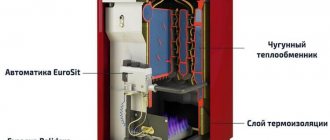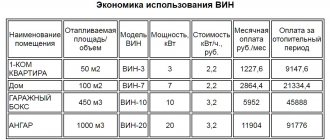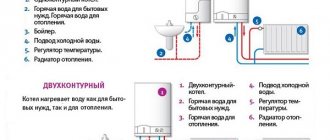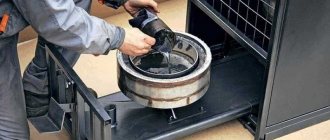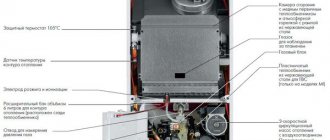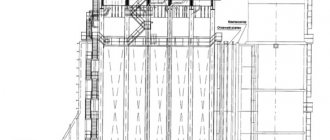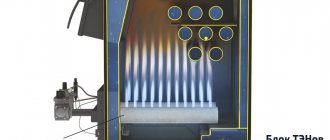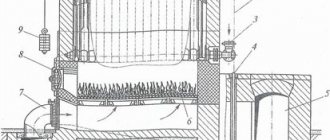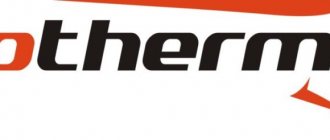What it is?
A heating unit designed to heat the coolant and supply it to the heating circuit.
Wall-mounted models are mounted in a hinged manner on solid walls. Since the load on the supporting structures should not exceed a certain limit, wall-mounted models are not too large. Their power is limited to 40-50 kW, and the most popular are models from 15 to 16 kW, designed to heat rooms from 150 to 260 m2.
Such units have an attractive appearance, which allows them to be installed in kitchens or hallways. Installation is allowed only on sufficiently strong walls - a plasterboard partition cannot be a load-bearing surface. Separate premises are not required for them, but installing gas equipment in living rooms is prohibited by the rules. If the model is equipped with an open type burner, then installation is allowed only in rooms with a closing door (for example, in the kitchen).
Choosing a single-circuit gas boiler for heating a private house
Boilers can be:
- Wall-mounted.
- Floor-standing.
Wall-mounted ones, as a rule, are lighter, less powerful, and more attention is paid to their design, because such equipment can be mounted in a visible place: in the kitchen or foyer. Floor-standing equipment is bulky and is designed to be installed on a solid base somewhere in a utility room.
Floor-standing single-circuit gas boiler
Burners:
- Atmospheric.
- Turbocharged.
An atmospheric burner is a natural draft of the chimney; air for its operation is taken from the room. It is included in the kit and is included in the price of the boiler. A turbocharged (pressurized or fan) burner must be purchased separately. But don’t rush to opt for a cheaper option! Let's compare burners according to other indicators:
- A pressurized burner has a higher efficiency; the fuel is burned almost completely.
- The atmospheric burner is sensitive to a drop in gas pressure in the system.
- In Europe, the top sellers have a fan burner because these models are more environmentally friendly.
- A boiler with an atmospheric burner must be installed in a room with excellent ventilation. Otherwise, the risk of poisoning increases.
In addition, the turbine burner can be replaced and the boiler can be transferred from liquefied gas to main gas (the boiler can be installed if there is no main gas yet, but it is planned to be installed soon).
Heat exchanger for gas boiler
Heat exchangers are made from:
- Cast iron.
- Become.
- Copper.
The steel version is less durable because it is susceptible to corrosion and has a small wall thickness. Cast iron makes the structure heavier and is afraid of the scale that forms on it, but it has twice the service life of steel. The undoubted leader in characteristics is copper. It is not subject to rust and will last a long time.
A cast iron heat exchanger can be damaged during transportation. But even if external damage is not visible, the heat exchanger may receive microcracks and this damage will make itself felt later, for example, when the equipment is subjected to a sharp temperature change.
Heat exchangers also differ in design and method of heat transfer:
- Primary. This is a tube with plates (the power will depend on the length and number of plates). Energy is transferred from gas to liquid.
- Secondary. These are plates fastened together. Energy is transferred from the hot coolant to the cold one.
- Bithermic. It is a pipe within a pipe and energy is transferred from gas to water, and then from water to water.
Having decided before purchasing which one suits you best:
- burner,
- heat exchanger,
- flue;
- boiler room...
You will make it easier for yourself to select equipment in the store. And having completed all the work conscientiously at once, you can forget about heating problems for years.
Electric boilers are chosen, as a rule, either by wealthy families, or if other methods of heating the room are not possible, or as an alternative source of heat for a short time. Double-circuit electric boiler: principle of operation and features of choice, as well as the advantages of this device.
We will consider the types and design features of quartz heaters in this section.
Where are they used?
As a rule, single-circuit boilers are used only for space heating. They are installed in a gap in the heating circuit, where they become the starting and ending point of the circulation cycle.
Single-circuit boilers are used to heat different rooms:
- private houses;
- apartments;
- dacha;
- offices;
- workshops;
- shops, etc.
Initially, these units were used for heating auxiliary premises, workshops, shops, etc. However, practice of use has shown their noticeable advantage over dual-circuit models. If an indirect heating boiler is used in conjunction with a single-circuit boiler, the supply of hot water is more stable and does not affect the quality of heating of the house; the only condition is the installation of a unit whose power is 10-15% higher than the value required for a given area.
Such a power reserve is needed to service the boiler, and the size of this reserve is determined by the volume of the heater. For a family with large needs for hot water (for example, if there are small children), choosing a single-circuit boiler paired with a storage boiler is the best option, allowing you to use hot water in unlimited quantities.
When choosing a gas boiler model, you should determine your hot water needs. If they are small, you can buy a double-circuit boiler and save on buying a boiler. However, if the needs for domestic hot water are quite large, a single-circuit model would be the best solution.
When is it better to install a single-circuit heating boiler?
The feasibility of installing such a device depends on the following points:
- Will the site being developed require hot water supply? If there is no such need, a single-circuit heating boiler will be quite sufficient.
- How much hot water is expected to be used? To simultaneously service several points (shower, bath, kitchen), it is best to install a single-circuit boiler, since a double-circuit unit is capable of providing the system with a relatively small volume of hot water. And if, for example, two points are activated at once, this will immediately affect the temperature of the heated liquid.
- What is the quality of tap water? If it is hard, then using a dual-circuit device is not recommended, since its heat exchanger will quickly become covered with scale, as a result of which it will have to be changed periodically. Therefore, here also a more suitable option would be to use a single-circuit device.
Device, design features
The design of a single-circuit boiler is a flow-through heater, the main element of which is a gas burner and a heat exchanger. They are combined into one unit, which allows creating conditions for maximum fuel combustion efficiency.
There are two burner designs:
- open (or atmospheric) . It was originally used on non-volatile models, but today it is also found on modern designs. Combustion air is taken directly from the room, which simplifies the operation of the burner, but makes it dependent on drafts, pressure changes and other external conditions;
- closed (turbocharged) . A turbofan is installed to supply air. The air flow is stabilized and does not depend on external factors. The smoke is also removed using a fan, which eliminates backdraft and other undesirable effects.
Boilers with a closed burner are much more convenient and safer. But they depend on the condition of the fan and require power supply.
What is the burner design in your gas heating boiler?
OpenClosed
There are models with different heat transfer methods:
- convection _ These are boilers equipped with conventional open or closed burners;
- condensation _ These are structures in which the coolant is heated in stages. First, primary heating is carried out using thermal energy obtained by condensing water vapor from flue gases. For this purpose, the boiler is equipped with a special condensation chamber. The second stage is conventional convection heating in a heat exchanger.
Expert opinion
Torsunov Pavel Maksimovich
Convection models are much more widespread than condensation models. They are able to work in any conditions and do not require any additional devices. Condensation models appeared relatively recently. They are only able to work under certain conditions.
For example, the difference between the temperature of indoor and outdoor air should not exceed 20°, otherwise the condensation process will become impossible. For Russia, where in the cold season the temperature difference is about 25°-35° or more, the use of such structures is useless. Considering that their cost is almost twice as high as that of conventional condensing models, the lack of demand is understandable.
Boiler installation requirements
The first thing that will affect the installation method is the combustion chamber.
If it is open (i.e. with natural draft), then the boiler will need a boiler room and a full-fledged chimney.
The air for the combustion process will be used internally, from the house, so serious requirements are also placed on ventilation.
For single-circuit boilers with a closed draft, the requirements are not so strict. Its design includes a fan (or even two), which creates thrust. This allows:
- Instead of a long chimney, make a horizontal gas outlet through a coaxial pipe.
- Place the unit in a residential area (kitchen, for example).
- Do not worry about ventilation, since the coaxial pipe provides air flow from the street.
The room where the boiler is installed must be of a certain size: minimum 15 m3. But for very powerful equipment the standard applies: 0.2 m3 per 1 kW of power. The width of the front door is 80 cm, and there must be a window.
Other installation requirements:
- The unit should not be placed closer to the wall than 5 cm.
- The wall made of flammable materials near (or on which) the device is located must be insulated with a metal sheet or other non-combustible material at least 3 mm thick.
- There should be at least half a meter to the ceiling, and 80 cm to the floor.
- It is carefully checked how level the unit is installed without any distortions.
Heating system with a single-circuit gas boiler and heated floors in a visual diagram
Electrical part:
- For volatile boilers, you need to lay a separate cable, switch and stabilizer.
- The equipment must be grounded.
Flue:
- The documentation for the device indicates what diameter of the chimney it should have. A smaller size is not acceptable.
- Horizontal bends should not be longer than 3 m, with a slope towards the boiler;
- Along the entire length of the gas duct - no more than 3 bends or turns;
- When joining fragments of a gas duct, one pipe must fit into the other by 0.5 of its diameter or more;
- If natural draft is used, the pipe should rise 50 cm above the roof ridge.
- The gas duct must not be routed through living rooms.
- It should not be made of porous, slag-concrete building materials.
When gases burn, condensate is formed, which contains a high content of sulfuric acid. This must be taken into account when organizing condensate collection and when choosing building materials for the flue.
Advantages and disadvantages
The advantages of single-circuit wall-mounted gas boilers are:
- compact size and attractive appearance;
- the absence of an additional heat exchanger simplifies the design and makes the unit more reliable;
- absence of noise during operation, allowing the boiler to be installed in kitchens or bathrooms;
- economical fuel consumption;
- stable operation, no loss of thermal energy;
- the ability to connect an external storage boiler, providing hot water in large quantities.
The disadvantages of single-circuit gas wall-mounted boilers are:
- existing restrictions in size and power make it impossible to use units in large houses or large premises;
- for a full supply of hot water, additional equipment (boiler) is required;
- most models are sensitive to water quality and stable power supply;
- Despite the limited functionality, care and maintenance of boilers is no less than when using double-circuit models.
The disadvantages of single-circuit wall-mounted models are not considered too significant, so many experts attribute them to design features.
Well-known companies and manufacturers
Single-circuit wall-mounted gas boilers are popular devices that are in high demand. For this reason, such designs are produced by all well-known manufacturers of heating devices.
Recognized leaders in this field of technology are German companies:
Italian companies practically do not lag behind them either in quality or in price:
Gas boilers from Czech and Slovak companies are distinguished by high quality and affordable prices:
In addition to them, Korean boilers from Navien or Kiturami, as well as Russian Lemax, Aton, Siberia, ZhMZ, are widely known. All these models are of high quality, capable of working in different conditions and performing their tasks in residential, public or industrial premises.
Installation features
Installation of wall-mounted boilers is carried out in a certain sequence. Installation is carried out on a solid, ideally load-bearing (outer) wall. This is an important point, since models with a closed burner use a coaxial chimney (pipe-in-pipe design) that is vented outside.
As a rule, the delivery set includes a special template according to which the wall is marked. Mark the attachment points and the center of the hole for the chimney.
The hole is made with a diamond crown using special guides that feed the cutting tool onto the wall. While drilling, it is recommended to water the crown, otherwise there will be a huge amount of dust and it will become impossible to work.
After making the hole, the chimney is led into it. It is a double pipe. Air is supplied through the outer one, and smoke is exhausted through the inner one. All gaps are sealed with insulating material and the installation of the boiler itself begins.
The unit is fixed with special fasteners included in the delivery set. Connect the gas supply pipe, water make-up pipe, forward and return lines of the heating circuit. All connections must be made carefully and carefully so as not to mix up any pipelines.
The last step will be to connect the boiler to the power supply, fill it with water, supply gas and test switch it on. All detected deficiencies are immediately eliminated.
Expert opinion
Torsunov Pavel Maksimovich
Installation, configuration and first start-up must be performed by service center employees. This is a condition of the warranty agreement. If installation and connection are performed independently, the warranty agreement may be considered terminated. In addition, independent connection of gas equipment is prohibited by current rules, so it is necessary to invite specialists.
Operation of a two-circuit system
All boilers are created according to one typical design, although they may differ in the design of individual components and their location. The design of a double-circuit heating device includes a large number of elements, various sensors and devices for monitoring the system and its automatic operating mode. This type of device can operate simultaneously in one mode: either as a heating system or as a hot water supply circuit.
The most important elements of a gas double-circuit design are:
- gas burner (in combination with a smoke exhaust system);
- heat exchangers (main heating system and hot water supply system);
- expansion tank;
- control board.
The long service life and efficiency of the double-circuit boiler depend on the proper functioning of these parts of the structure.
Gas boiler design
Gas-burner
The gas burner is the main part of the structure; fuel is supplied to it through a gas valve. This process is regulated by an electronic board, and the owner uses it through the control panel to set the desired temperature of both boiler circuits. The burner is located in the combustion chamber, where exhaust gases are removed, and there is also a fan and a monostat. After fuel is supplied and started, the burner operates for a long time, raising the temperature in the heating circuit to the set level. After this, the fuel supply stops, the generated heat heats the water, which then disperses in a forced mode throughout the entire system. Thanks to the three-way valve, the coolant (water) moves through the main heat exchanger without affecting the DHW circuit.
In a double-circuit gas boiler, the hot water supply is turned on when the water tap is turned on. With this action, the water flow is switched by a three-way valve, as a result of which the heating system is turned off. At the same moment, the burner is ignited (if it was not working before) and the hot coolant is sent to the DHW heat exchanger, that is, the secondary one. The movement of water through the hot water supply system occurs through a small circulation circle.
Heat exchangers
In a double-circuit boiler, heat exchangers are installed for the primary (heating system) and secondary (DHW) circuits. The main one - the primary one - is a system of copper tubes, located above the burner, in which the coolant of the heating system is heated and circulated. The secondary heat exchanger is used for the DHW circuit - this is a set of plates that warm the water until the “hot” tap opens. After this, a signal is sent to the control unit, the three-way valve closes, and the heating operation stops. The water has passed through the secondary heat exchanger and flows from the tap.
Expansion tank
When water heats up in the heating system, heat is released and pressure increases, which the expansion tank helps compensate for. The tank design consists of 3 components:
- space for coolant in the heating system;
- membranes;
- space pumped with nitrogen.
When the heating system is operating, the membrane in the design helps to compensate for the increase in pressure of the heated water, so that the boiler is not at risk of explosion.
Control board
The entire design of the gas boiler is under the control of a control board (electronic unit), thanks to which it is possible to set the optimal operating modes of the heating device and monitor all sensors. All board settings are adjusted and “sewn” into the unit at the factory, but the owner can additionally connect an external temperature sensor so that the design will automatically start if the room gets cold.
Exploitation
All rules and requirements for the operation of a gas single-circuit boiler are described in detail in the instructions, which must be carefully studied.
Each model differs from others in certain specific features, so it is important to understand in advance all the requirements set forth by the manufacturer.
In addition, it is necessary to create conditions for trouble-free operation of the boiler. Experts recommend using a voltage stabilizer, since the electronic control unit is sensitive to the quality of the power supply. If surges occur or the voltage does not meet the specified parameters, errors may occur, and sometimes the control unit burns out.
When connecting to the power supply network, it is imperative to make a good grounding, otherwise the self-diagnosis system will begin to give incorrect information and constantly show an error.
Water quality is also an important factor. If the water in the region is too hard, softeners and special filters must be used. Scale in the heat exchanger slows down heat transfer, which means you have to increase the temperature. Excessive heating quickly damages boiler parts, and excessive gas consumption increases the payment amount.
Wall-mounted single-circuit gas boilers are convenient and popular sources of thermal energy in private houses, apartments and other premises. They are reliable, durable, and able to work in difficult conditions. At the same time, the user must ensure all the manufacturer’s requirements in order to keep the unit in order for its entire service life.
The main advantage of a single-circuit boiler is the ability to work in tandem with a storage boiler, which allows you to provide the room with hot water in sufficient quantities. Gas single-circuit wall-mounted boilers are highly rated by their owners and are in high demand.
Principle of operation
The operating principle of single-circuit boilers is quite simple, and a higher education in engineering or physics is not required to understand all the design flaws. During installation, the device is connected to the chimney; in most cases, natural draft is sufficient, but you can install additional hoods and special fans if you want to avoid blowing out the flame. This is especially worth doing if you decide to cut the price and purchase more than one of the automated devices that have built-in protection against almost everything and turn off the gas supply if the flame goes out.
You might be interested >> Description of the Proterm floor-standing gas boiler
Boilers come with open and closed combustion chambers. The first type is most often used, but it also requires compliance with certain conditions during installation. And, first of all, you should worry about fire safety by covering the walls with special heat-resistant paint or additional protection. It is also necessary to comply with sanitary and hygienic standards of cleanliness.
Important. Oxygen is required for the flame to fan and burn freely, and combustion products, if installed incorrectly, can easily pollute the boiler room. Accordingly, it is better to install autonomous heating in a separate room or annex.
Gases harmful to the human body can accumulate even with free airflow into the boiler, so it is necessary to take care of additional exhaust hood. All the conditions described will maximally protect the autonomous heating system, eliminate interruptions and blowing out the flame, thereby protecting you and your family from the risks of explosion and spontaneous combustion of the room. But still, before making any design sketches, contact and consult with a specialist. This will save you time and give you confidence that your technical specifications and drawing will be approved by the gas service.
